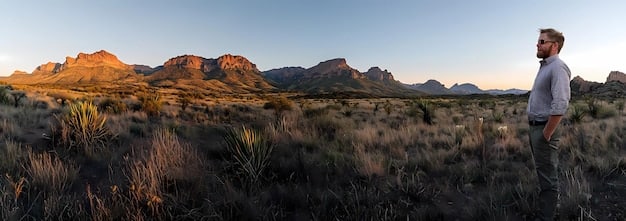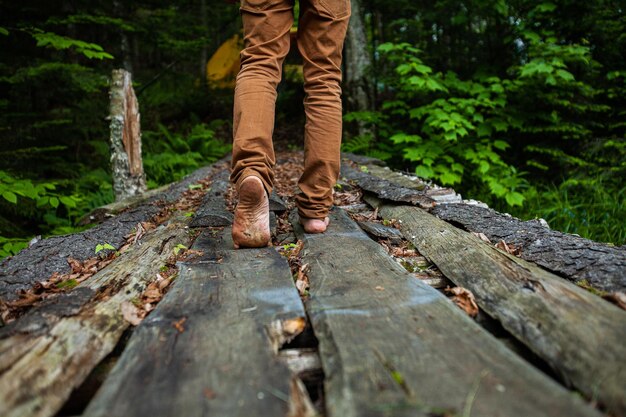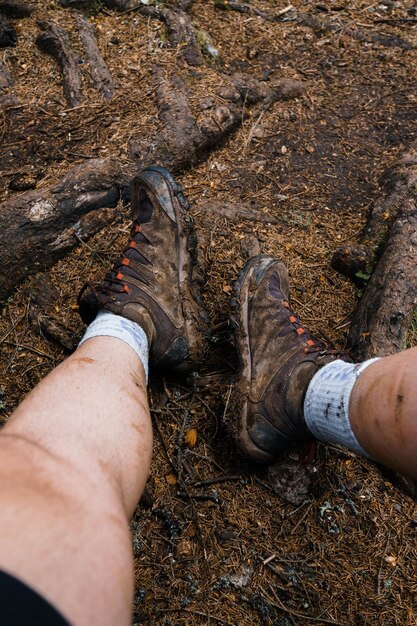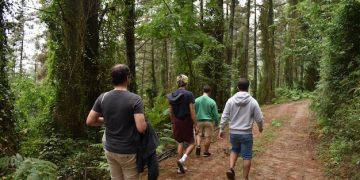Ethical Hiking in the US: Tips for Minimizing Your Impact

Ethical hiking in the US involves making conscious choices to minimize your impact on trails and wildlife, preserving these natural spaces for future generations through responsible behavior and sustainable practices.
Embarking on a hiking adventure in the United States offers a chance to connect with nature and discover breathtaking landscapes. However, it’s crucial to remember that these pristine environments are delicate and susceptible to human impact. Practicing ethical hiking in the US: minimizing your impact on trails and wildlife ensures we can enjoy these outdoor spaces responsibly, preserving them for future generations.
Understanding the Principles of Ethical Hiking
Ethical hiking goes beyond simply following trail markers; it’s about adopting a mindset of respect and responsibility towards the environment and its inhabitants. It encompasses a range of practices designed to minimize negative impacts and promote conservation.
By understanding and implementing these principles, we can collectively contribute to preserving the natural beauty and ecological integrity of hiking destinations across the US.
Leave No Trace
The Leave No Trace principle is fundamental to ethical hiking. It emphasizes minimizing our physical and visual impact on the environment.
- Pack it in, pack it out: Carry out everything you carry in, including food wrappers, plastic bottles, and even biodegradable items like fruit peels.
- Minimize campfire impacts: Use established fire rings or stoves for cooking. If building a fire, keep it small and contained, and be sure to completely extinguish it before leaving.
- Dispose of waste properly: Pack out human waste or use designated toilet facilities. If these are unavailable, bury human waste in a cathole at least 200 feet away from water sources and trails.
Respect Wildlife
Wildlife encounters are a thrilling aspect of hiking. However, it’s vital to maintain a safe distance and avoid disrupting their natural behavior.
- Observe from a distance: Use binoculars or a telephoto lens to view wildlife. Avoid approaching animals or provoking a reaction.
- Never feed wildlife: Feeding animals can alter their natural foraging habits, making them dependent on humans. It can also spread diseases and attract unwanted attention.
- Store food properly: Keep food stored in bear-resistant containers or hang it from a tree to prevent attracting animals to your campsite.
By adhering to these principles, we can ensure that our hiking adventures do not compromise the health and well-being of the environment and its inhabitants.

Staying on Designated Trails
Designated trails are carefully designed to minimize erosion and protect fragile ecosystems. Straying from these paths can cause significant damage to vegetation, soil, and water sources.
By staying on the trail, hikers contribute to the preservation of trail integrity and the surrounding environment.
Preventing Trail Erosion
Trail erosion is a major concern in popular hiking areas. When hikers cut switchbacks or create shortcuts, they accelerate the erosion process, leading to wider trails and increased runoff.
Staying on designated trails helps to minimize soil compaction and prevent the formation of gullies. It also protects the root systems of plants, which help to stabilize the soil.
Protecting Vegetation
Straying from the trail can trample delicate vegetation, including wildflowers, seedlings, and ground cover. This can disrupt plant communities and damage sensitive habitats.
Many alpine plants are particularly vulnerable to trampling. They grow slowly and are easily damaged by foot traffic. Staying on the trail helps to protect these fragile species.
Always stay within the established trail boundaries, even if it means taking a longer route. Your steps can make a big difference in protecting the natural environment.
Choosing Sustainable Gear and Practices
The gear we use and the practices we adopt can significantly impact the environment. Choosing sustainable alternatives and minimizing waste are essential components of ethical hiking.
By making informed choices about gear and practices, hikers can reduce their ecological footprint and contribute to a more sustainable outdoor experience.
- Use reusable water bottles and containers: Avoid single-use plastic bottles and opt for reusable alternatives. Carry a reusable water bottle and refill it at water sources along the trail.
- Choose biodegradable soap and detergents: When washing dishes or clothes, use biodegradable soap and detergents. Dispose of wastewater at least 200 feet away from water sources.
- Pack out all trash: Bring trash bags and pack out all garbage, including food wrappers, plastic bags, and other waste.
- Select durable and long-lasting gear: Invest in high-quality gear that is built to last. This reduces the need for frequent replacements and minimizes waste.
- Repair gear instead of replacing it: When possible, repair damaged gear instead of buying new items. Many outdoor retailers offer repair services or sell repair kits.
- Rent or borrow gear: Consider renting or borrowing gear for occasional trips. This can save money and reduce the environmental impact of manufacturing new equipment.
Choosing sustainable gear and practices is an ongoing process. By making conscious choices and seeking out eco-friendly alternatives, hikers can minimize their impact on the environment.

Avoiding Disturbing Water Sources
Water sources are vital to both humans and wildlife. It’s crucial to avoid disturbing or polluting these sources while hiking.
By respecting water sources, hikers can help maintain water quality and protect the health of ecosystems.
Practice Proper Hygiene
When washing dishes or clothes, do so at least 200 feet away from water sources. Use biodegradable soap and detergents, and dispose of wastewater in a designated area.
Never use soap or detergents directly in streams, lakes, or ponds. This can pollute the water and harm aquatic life.
Protect Water Quality
Avoid wading or swimming in water sources, especially in sensitive areas. This can stir up sediment and introduce pollutants.
Refrain from throwing rocks or other objects into water sources. This can disturb aquatic habitats and harm or kill aquatic animals.
Take extra care to protect water sources from contamination. They are essential for maintaining the health of our environment.
Planning Ahead and Being Prepared
Proper planning and preparation are essential for a safe and ethical hiking experience. Knowing the trail conditions, weather forecast, and potential hazards can help hikers minimize their impact on the environment.
By planning ahead and being prepared, hikers can avoid situations that might lead to environmental damage or harm to wildlife.
Research Trail Conditions
Before embarking on a hike, research the trail conditions. Check for closures, warnings, and recent reports of environmental impacts.
Choose trails that are suitable for your skill level and experience. Avoid trails that are known to be fragile or sensitive to human impact.
Check the Weather Forecast
Be aware of the weather forecast and potential hazards, such as thunderstorms, flash floods, or extreme temperatures. Adjust your plans as needed.
Avoid hiking during periods of heavy rain or snow. This can increase trail erosion and damage sensitive vegetation.
Pack Essentials
Carry essential supplies, including a map, compass, first-aid kit, water, food, and a headlamp. Be prepared for unexpected situations.
Pack extra layers of clothing to protect yourself from changing weather conditions. This can help you avoid starting a fire for warmth in an emergency.
Navigating Responsibly
Use maps and compasses to navigate trails, minimizing reliance on electronic devices that might require frequent charging.
Learn to identify trail markers and follow them closely, avoiding shortcuts that can lead to environmental damage.
By planning ahead and being prepared, hikers can reduce their risk of accidents and minimize their impact on the environment.
Educating Others and Promoting Ethical Hiking
One of the most impactful ways to protect hiking trails is to educate others about ethical practices. Sharing knowledge and inspiring responsible behavior can create a ripple effect that benefits the entire hiking community.
By educating others and promoting ethical hiking, we can collectively contribute to the preservation of our natural spaces.
Lead by Example
The best way to influence others is to lead by example. Demonstrate ethical hiking practices whenever you are on the trail.
Pack out all your trash, stay on designated trails, and respect wildlife. Your actions will speak louder than words.
Share Your Knowledge
Share your knowledge of ethical hiking practices with friends, family, and fellow hikers. Explain the importance of minimizing our impact on the environment.
Offer practical tips and suggestions for adopting sustainable behaviors. Encourage others to embrace a mindset of respect and responsibility.
Support Organizations
Support organizations that promote ethical hiking and conservation. Volunteer your time or donate to their causes.
These organizations play a vital role in protecting our hiking trails and educating the public about responsible outdoor practices.
Share what you’ve learned with other hikers or trail users! Helping others understand the importance of sustainable practices and sharing your experience can help to spread environmentally friendly habits on the trail. Together we can make a difference.
| Key Point | Brief Description |
|---|---|
| 🗑️ Pack It In, Pack It Out | Carry out everything you bring in, leaving no waste behind. |
| 🐾 Stay on Trails | Stick to designated paths to prevent erosion and protect vegetation. |
| 🐻 Respect Wildlife | Observe animals from a distance and never feed them. |
| 💧 Protect Water Sources | Keep water clean by practicing hygiene away from streams and lakes. |
Frequently Asked Questions
▼
Ethical hiking involves minimizing your impact on the environment, respecting wildlife, and adhering to Leave No Trace principles. It’s about enjoying the outdoors responsibly.
▼
Staying on designated trails prevents erosion, protects vegetation, and minimizes disturbance to fragile ecosystems. This helps preserve the integrity of the trail.
▼
Pack out all trash, including food wrappers and plastic bags. If toilet facilities aren’t available, bury human waste at least 200 feet from water sources.
▼
Observe wildlife from a distance and avoid approaching or feeding animals. Store food properly to prevent attracting them to your campsite, ensuring safety.
▼
Lead by example, share your knowledge about sustainable practices, and support organizations promoting ethical hiking and conservation. Every small act helps.
Conclusion
By embracing the principles of ethical hiking in the US: minimizing your impact on trails and wildlife, we can ensure that our outdoor adventures are both enjoyable and environmentally responsible. Let’s commit to preserving the natural beauty of our trails for future generations to appreciate.





